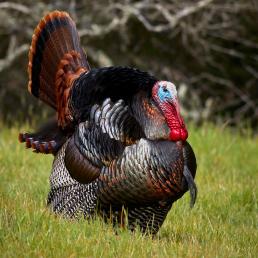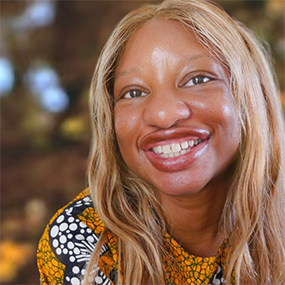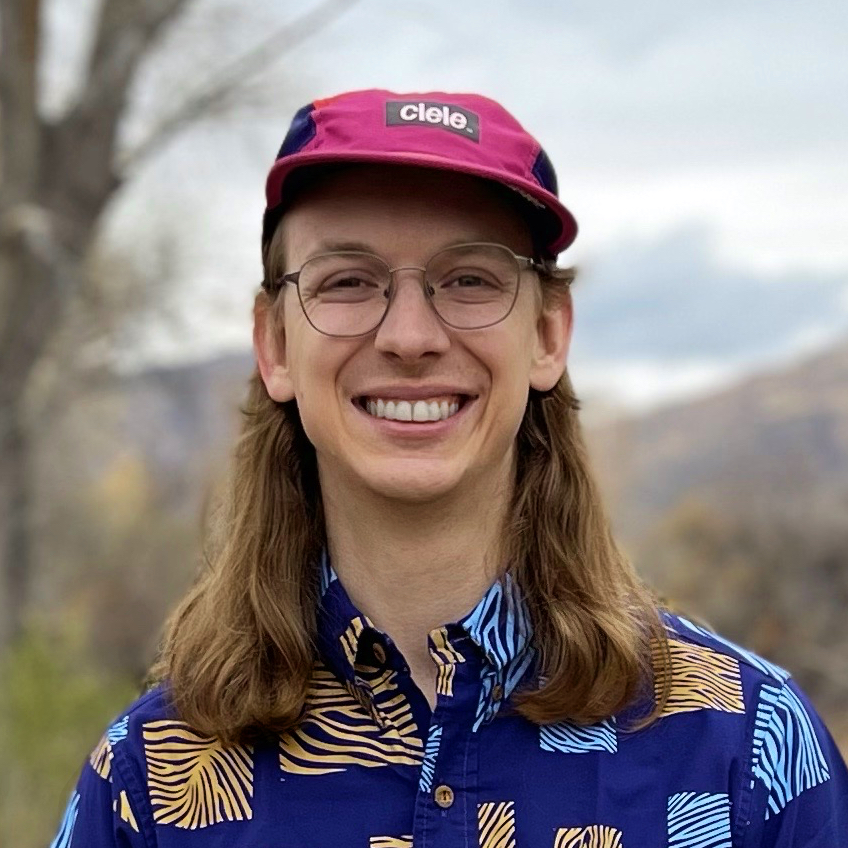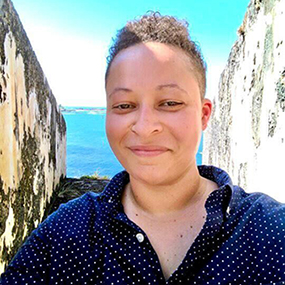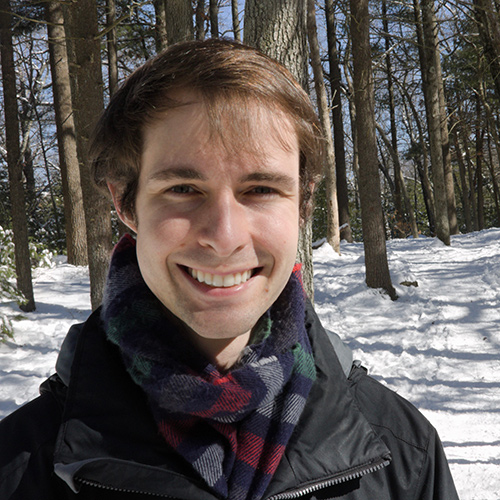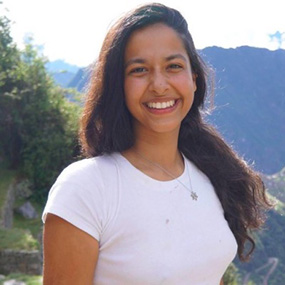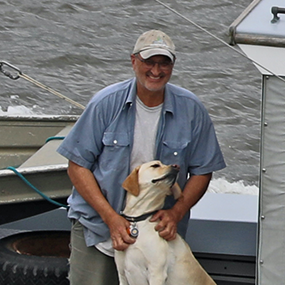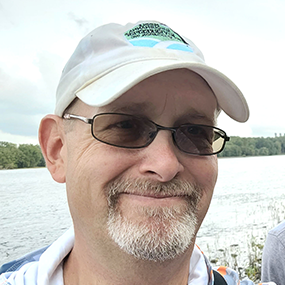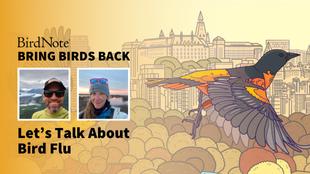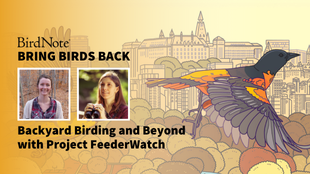

Join BirdNote tomorrow, November 30th!
Illustrator David Sibley and actor H. Jon Benjamin will face off in the bird illustration battle of the century during BirdNote's Year-end Celebration and Auction!
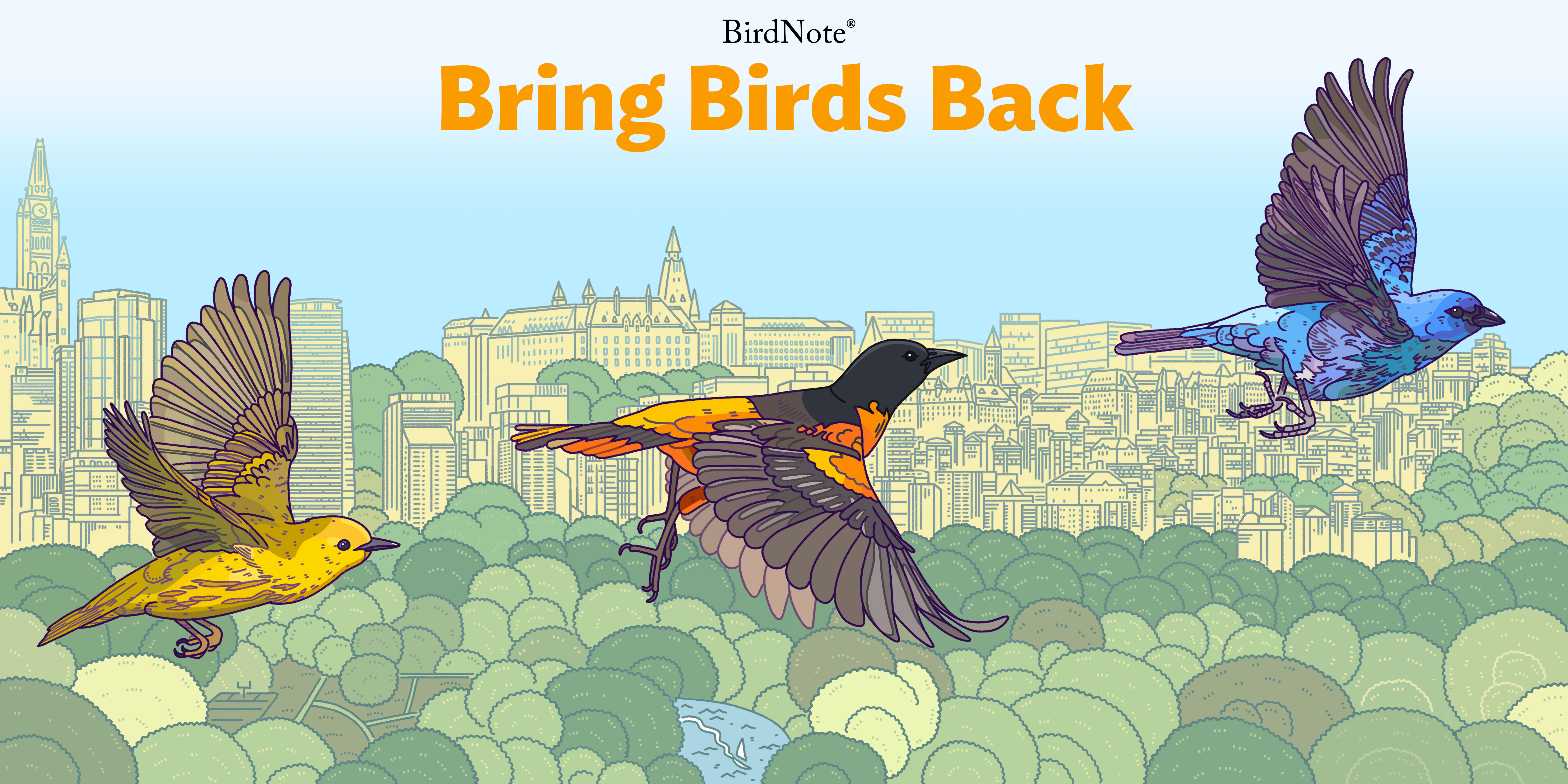
Water is essential for life, but how much do you know about the health of your local water supply? In this special episode, we speak with two Riverkeepers who explain the importance of water quality monitoring for every living organism, from humans to birds. John Lipscomb shares critical history of the Hudson River and how activism has helped the neighborhood thrive. And John Zaktansky introduces us to Doug Fessler and the technology of BirdNET for his hi-tech patrol. Co-produced by our guest host, Trisha Mukherjee. Tune in!
For more information about the From Love to Action campaign, episode transcript and other resources from this episode, visit BirdNote.org.
Want more Bring Birds Back? Subscribe to our show and follow us on Instagram! For more about BirdNote, sign up for our weekly newsletter. And for ad-free listening and other perks, sign up for BirdNote+ here.
BirdNote is a nonprofit. Your tax-deductible gift makes these shows possible.
Bring Birds Back Special Season 5 is sponsored by the Cornell Lab of Ornithology.
[Bring Birds Back Stinger]
Trisha Mukherjee: BirdNote Presents
From BirdNote, this is Bring Birds Back. I’m your guest-host, Trisha Mukherjee. I’m a journalist covering global human rights, and some of my favorite reporting has been about the people who protect our earth.
[Jazzy upright bass and piano music begins]
[Sounds of traffic and honking in NYC fade in]
I live in New York City. 8 million people, super densely populated. Most people wouldn’t associate NYC with nature. But I’ve always gravitated to the rivers nearby.
[City noises fade out; the gentle lapping of a river fades in]
Like along the Hudson, I love biking and running, and even kayaking in the summer. And in college, I took a sailing class and zigzagged across the water, propelled by the wind.
But sometimes, when I look at the river, dancing and swaying, I’m reminded it’s a living thing. And I wonder – who takes care of it?
I mean, people have historically seen the river as a dump. A place to throw trash and other waste products. Climate change only makes things worse as it threatens species that live in - and along the water. And rivers are a life source not just for fish and birds, but also for people. So who ensures that the river is safe, clean, healthy?
That’s where the Riverkeepers come in.
The Riverkeepers – they sound like a group of climate superheroes. And that’s kind of what they are. Spread across the country, they're part of a network of people advocating on behalf of their local rivers. But instead of wearing capes, and flying from place to place fighting crime, they wear waterproof boots and travel hundreds of miles in patrol boats to save plants, animals, and the river itself. Not to mention all the people that depend on the river, too.
It’s hard work and the act of guarding waters has a long, extensive history predating colonialism. In 1966, the Hudson River Fishermen’s Association was formed to combat rising waste and sewage issues. It invoked two laws: the Rivers and Harbors Act of 1888, which banned the pollution of waters in the U.S. and the Refuse Act of 1899, which offered a reward to anyone who reported violations of the first law.
The association’s actions inspired many other environmental organizations across the country to do the same for their own rivers. The Hudson River Fishermen's Association eventually renamed itself, “Riverkeeper,” famously coining the term that’s been adopted for this work worldwide. Riverkeeper organizations eventually spread into a nationwide network.
In this special episode of Bring Birds Back, we'll meet two Riverkeepers who are protecting their waterways by using strategies old and new. Later, you'll hear from Middle Susquehanna Riverkeeper John Zaktansky and his friend Doug Fessler about how they’re working with birds to better the rivers of Pennsylvania. And we'll tell you how you can join BirdNote's campaign to mobilize a million people to help the environment.
But first up is John Lipscomb who will share with us how big corporations often get in the way of quality water health. On a sunny day in Ossining, New York, I met John… and his four legged assistant.
Come here. Oh! Oh my goodness! Batu!
John Lipscomb: Come, Batu, come. I'm trying to help you. Come, come, right here. Just get in close. Sit right here. Sit right here, stay.
Trisha Mukherjee: John Lipscomb is Patrol Boat Captain and Vice President for Advocacy for Riverkeeper, an organization that works to protect the Hudson River’s water quality. I joined him out on the Hudson. He’s been protecting this river system for 23 years now. And when Bob Boyle, founder of Riverkeeper's predecessor, approached John for the job, a surprising element drew John in.
John Lipscomb: To be honest, I joined Riverkeeper because of the boat. I'm predisposed to workboats. And nothing against any other boat, but they don't make my heart sing.
She's called the R. Ian Fletcher, after a scientist that Bob Boyle worked with on behalf of the river. The Riverkeeper boat, the Fletcher, was built to work on Delaware Bay on oyster beds. And she's rough and she's not elegant in the way that yachts are, but she's elegant to my eye.
Trisha Mukherjee: John took me out to Croton Point on the Hudson. An idyllic scene, but beneath the surface things are more complicated.
John Lipscomb: Okay, where we're anchored right now... It would be easy to assume that the world is all good, you know? I mean, I come to this park at Croton Point often and there are Red-tailed Hawk and Bald Eagles, and... The river has been severely damaged since the time that Europeans showed up in North America. Some of the things that happen can never be fixed.
Croton Point was one of the largest Indigenous communities in the Hudson Valley. They had fresh water from the Croton River, they had oysters and fish from the Hudson, they had fuel in the firewood. Europeans built our communities along rivers, and that's been a real problem for rivers. Whether it's the dust from tires, whether it's the untreated sewage, that's a huge problem, a present day problem, a problem to solve going forward.
Trisha Mukherjee: And those are just a few of the problems John is facing as a protector of rivers. The issues are varied and complex, from habitat destruction, droughts, climate change and pollution to heavy metals, gas, pipe erosion, and other hazardous substances. And that means they require multiple solutions.
So, given all these challenges, what’s involved in your role as a Riverkeeper?
John Lipscomb: Our job is to be the eyes and ears and voice for the river. We patrol from New York Harbor around Manhattan, Newtown Creek, out to LaGuardia. We run the estuary, 155 miles, and then we also patrol on the Mohawk River, which is the largest tributary to the Hudson. We want to be present, you know, and the first thing I did is I printed Riverkeeper on the side of the boat with foot high letters, black on the white hull. You know, the most basic message.
Trisha Mukherjee: John hopes that people see him on his boat and think about the river needing protection, that there are people out there who care deeply — and maybe also get polluters to think twice about their actions. When John finds evidence of pollution or habitat destruction, he prompts environmental authorities to enforce anti-pollution laws and stop the damage.
John Lipscomb: So, on the Rondout Creek in Kingston, for example, in the early years, we had a number of small enforcements against facilities on the shore, you know, construction without a permit, illegal fill.
In the last ten years, I haven't seen any issues there. And I like to think that it's because that Riverkeeper boat — with “Riverkeeper” on the side, as bold as can be — comes in and out every patrol four times a month. I like to think that the word got out.
And I have to say, a lot of these enforcements, we try to do them as gently as possible. If a polluter is deliberately polluting, then we hit him as hard as we can. For example, to discharge waste so they don't have to handle it — which costs money, they want to save money so they pollute the river — we don't hesitate to enforce.
But if it's a shore-side facility, let's say a boat club, a marina, even a community, where through lack of attention, or not understanding the permitting, or an honest mistake — everybody makes mistakes — there, we do act, but we try to do it in a way that doesn't result in fines.
We want the problem solved.
And we want to maintain the relationship, because it's a big river, but it's really a very small neighborhood.
Trisha Mukherjee: Like back in 2002 with Newtown Creek. "Creek" doesn't really capture it — it's a 3 and a half mile long waterway — as wide as a river — that runs between Brooklyn and Queens in Long Island. Eons ago it was a salt marsh, but you wouldn't know that today.
John Lipscomb: It became a great place for industry, and legacy pollution in Newtown Creek is unbelievable.
We went in there in 2002, and we saw black oil all over the water, and it turns out it was the largest underground oil spill in North America, right there in Brooklyn, in Greenpoint. Coast Guard knew about it. DEC knew about it. EPA knew about it.
Trisha Mukherjee: John’s referring to three of the most instrumental government entities regarding the patrol of coastal waters and natural habitats in the nation: the EPA or the Environmental Protection Agency, the Coast Guard, and the DEC, or Department of Environmental Conservation, in this case for New York State.
John Lipscomb: The mitigation steps that were being taken were completely inadequate. The property is owned by Exxon, but I want to be clear, they didn't do all the spilling. The spills went back to the time of Standard Oil, when Rockefeller was in that business. So it's been many, many spills over time, and many accidents, and so forth.
But when Exxon bought the property, they bought the assets and the liabilities. And so they have to deal with it. And we went to court against Exxon. I think we had about 15 staff and I think at the time, Exxon may have been the richest company on Earth.
And it took 8 years. It really was a case of David and Goliath. The problem in Newtown Creek is the public can't see the creek from the shoreline, so we were taking people on the water to have people see the pollution from the creek's point of view. We were saying that you have to deal with this. You have to set- have a clean up plan.
It became a popular cause in New York City, and we would take the boat down there multiple times a month, and we would take New York City Council people, we would take the press, we would take the locals, we ended up being joined by the Attorney General of the State of New York.
Well, all of a sudden it's not such an unequal fight. It's not just 15 people at Riverkeeper against Exxon, it's the state of New York versus Exxon. And, uh, they ended up settling and a fund was created and now there's a local group called Newtown Creek Alliance. They have an office on the creek. They patrol all the time.
You know, when we went into Newtown Creek, there was no one there but us. And now, Newtown Creek has Newtown Creek Alliance and Riverkeeper and LaGuardia College, and other allies– and it's never going to be alone again.
[Curious music starts]
Trisha Mukherjee: Within Exxon’s $25 million dollar settlement reached in 2010 for penalties and clean-up costs, $19.5 million of that fee became a record payout for developing environmental projects in New York State, solely awarded to the affected community. The reward for the Greenpoint Oil Spill garnered attention and momentum that led to millions of gallons of oil removed from the spill site, which in turn prevented further contamination into the Creek.
And yet, there are still a number of other spills seeping into the Creek that have yet to properly be addressed both on the ground and in the courts, rendering Newtown Creek clean-up far from complete.
John Lipscomb: While we have a Clean Water Act that's 50 years old that says the waters of the United States shall be fishable and swimmable. When I take people into Newtown Creek in a small boat, journalists or whoever — the water is so visibly polluted that they're scared of the water.
These are people who got up in the morning, brushed their teeth with water, showered with water, made their coffee with water, and then they get in this boat and they come with us and they're scared of the water. I've had people, when they got a splash on them, actually scream out in fear. That's not okay. That's not okay. You know, humans can choose whether they want to go and touch the water, but aquatic life has no choice.
[Music ends]
Trisha Mukherjee: Riverkeepers take on many different roles while watching over the waters: neighbor, guardian, policy advocate and activist. And another role many adopt is that of steward, introducing people to the waters that surround them.
John Zaktansky: I mean, where we live, it's extremely rural, and you would just assume that everyone living in river towns would automatically have a connection to the river.
Trisha Mukherjee: That’s John Zaktansky, we’ll refer to him by his last name.
John Zaktansky: And it surprises me how few of these kids have ever held a fishing pole or a kayak paddle or have been out of their house to do outdoor activities, and it's new to them. And it's just an opportunity to really connect them in a way, a meaningful way, as a community to these resources. And if we want younger people in our community to have these stewards in the future to do the work that we're doing right now, we need them to have the same meaningful experiences with our outdoor resources that we did when we were kids.
Trisha Mukherjee: Zaktansky has been protecting the Middle Susquehanna river for a few years now. As Riverkeeper, a big part of the job is patrolling the waterways, looking for signs of pollution or bad actors. But another part is being a visionary, responding to old problems in new ways.
What is your day-to-day like?
John Zaktansky: The day to day is very different. I mean, one day could be in the office doing bookkeeping or filling out paperwork for a grant. And the next day waist deep in the water, doing water sampling or promotional video work
And sometimes I'm out knocking on people's doors, asking if I can test their residential well water to see if their water is safe to drink. Every day can be very different.
Trisha Mukherjee: Growing up, Zaktansky became deeply familiar with central Pennsylvania’s landscapes through camping and canoeing trips. His eight years as a counselor and nearly 20 years as an award-winning local news journalist has uniquely equipped him to both ask the important questions and find the answers to the unique problems of the Susquehanna River.
So I'm curious to learn a little bit more about the Susquehanna River.
John Zaktansky: It's a very, very special river in that it's one of the oldest rivers, not just in our country, but in the world, it's actually one of the five oldest rivers worldwide, but it's a river system that has a, a really long history of industrial use.
A lot of coal mining has happened over the years. And in fact, right now, we're dealing with what's called AMD, abandoned mine drainage issues in this area, so as water from rain and whatever else gets into these old abandoned coal mining industry shafts, the water connects with open rock structures that weren't meant to be connecting with water. And as the water connects with these rock structures, the water that comes out is carrying out a lot of acidity and certain heavy metals that are killing off water systems, streams, and stuff like that.
So, about an estimated 5,500 miles of streams are impacted and impaired right now in Pennsylvania, due to AMD issues in our state.
Trisha Mukherjee: “Impaired” is a term that environmental agencies use when a waterway has pollutants at levels that are deemed unsafe for use.
John Zaktansky: So you can actually go on Google Earth right now and you can actually see extremely bright orange flowing water coming into the Susquehanna River from these mine shafts. It's quite striking and a lot of that is dead. Like it just- life can't live in that and these streams are, are just can't support life.
Trisha Mukherjee: Abandoned mine drainage is one of the biggest problems water systems are facing today. And from infrastructure bills to treatment systems, there's a lot of work going into potential resolves and reversals, as the issue persists. But that's not the only thing threatening the waterways: there’s also natural gas fracking, runoff, stream bank erosion and microplastics to name a few.
For many years, PFAs have been building up in the water. PFAs, spelled P-F-A-S, is an acronym for long-lasting synthetic chemicals commonly found in products like non-stick pans and water-resistant fabric.
John Zaktansky: There's a better awareness of those things and PFAS and, and forever chemicals and the drug impacts of, of the stuff that we put through our bodies and how they get into our waterways and endocrine disruptors and, there's just a whole plethora of other things that we can do to kind of get things better than what they are now.
Trisha Mukherjee: And where they are now is very telling: 50 years of studies conducted about waterways and chemicals have shown that high levels of PFAs significantly increases the cancer risk of birds, fish and mammals in the aquatic food web. This has been proven particularly true in waterbirds such as cormorants and plovers, resulting in many of their chicks dying. While studies of this magnitude have prompted countries like Canada to set limits on particular types of PFAs, the United States’ EPA has yet to follow suit.
Zaktansky says education and exposure have so far been the best methods for getting the public involved, as local awareness has increased community participation and interest.
John Zaktansky: I've almost tripped over stories from local universities of research that they've done on things like microplastics they found in bass stomachs in our own backyard that local newspapers have never run, never even heard of.
And a lot of them have been extremely well received by anglers, people who are out fishing who are like, ‘Whoa, we didn't realize that, you know, the bass we catch are filled with these microplastics, or filled with these endocrine disruptors or a variety of other things.’ So I've been able to do stories on those and then amplify them across our watershed.
Trisha Mukherjee: Zaktansky’s wide-ranging network of volunteers led to a unique opportunity to work with Doug Fessler, who brought technological expertise to the team.
So, I think you mentioned that you were kind of monitoring an area, of- was it 11,000 square miles?
John Zaktansky: Yes. Yup.
Trisha Mukherjee: Wow.
John Zaktansky: You get very tired. It's a lot of walking. No, no, it's, it's a huge area, obviously, it's, and it's a very rural area. So, I mean, obviously, we rely a lot on people who are volunteers, and it led to this opportunity, and meeting Doug Fessler, who was out there for with his own family kind of, um, on their own doing this volunteer work, picking up trash and constantly trying to clean waterways. So, we're always looking for new ways to better monitor waterways across this larger area.
And in his mindset looking for a way to marry tech with environmental work, uh, where we came across this opportunity to do water monitoring through that aspect. This BirdNET project is one of those ways we're excited to engage a new way to do that.
[Transitional music break]
Trisha Mukherjee: Up next, meet Doug and find out how he and Zaktansky’s bird monitoring project got started, how birdsong is helping them keep their local water quality clean and later, simple steps you can take to get involved.
But first, a word from our sponsors:
MIDROLL
Trisha Mukherjee: And we’re back.
Zaktansky and Doug met as two people with a love for nature — and a passion for saving it. But their friendship has blossomed into their work life, as well. Doug is a 20-year veteran in Information Technology. And he’s bringing a recognition system called BirdNET to riverkeeping.
BirdNET is an AI algorithm developed by the Cornell Lab and their partners. It detects and classifies avian species based on their bird calls and songs. The software is readily available for anyone to download and use. And for Doug, it’s bridging the gap between his love for nature and tech.
Doug Fessler: My heart's always been into the environment. And I've always been looking for ways to merge the computer science field and the information technology field. And, I was born and raised around here, there's islands that are down at the end of town, out of the city. All types of critters, fish, there used to be the Eastern american toad, literally thousands carpeted across the islands. And when you'd walk, they just jump away from you. And over the course of years, I saw those things disappear.
Trisha Mukherjee: Although Doug didn’t become a Riverkeeper, he gained other skills that could hold the key to protecting our rivers in the modern era. These days, biologists often use remote recording devices so they can monitor a large area with a small team of people. Doug learned how to program a tiny computer called a Raspberry Pi that would let him create a monitoring device out of a small, portable object.
Doug Fessler: So, you know, being in IT for so long, like, there's things that are coming out open source - which means anyone can do anything with it - and you see people doing all these crazy projects with Raspberry Pi’s. So then it starts inspiring you because like, Oh, if they're doing that, I wonder if I can do this. And it's always like thinking outside the box.
And, uh, you know, doing searches on the internet. I came across a project called BirdNET through Cornell University, and they developed the software.
Trisha Mukherjee: Doug set up the BirdNET software on the Raspberry Pi devices, so it records and identifies bird sounds. Once documented, the devices automatically report their results online.
Doug Fessler: All the magic happens within the software itself. It uses machine learning to analyze those vocalizations. And then it saves everything into a very little SD card. It'll have internet connectivity and it uploads the data to birdweather.com. And anyone can get on that and look.
Trisha Mukherjee: It wasn’t easy to get all these features to work — plus, the recording devices had to survive the elements.
Doug Fessler: And I was having a hard time configuring it and there was a point where I'm like, I don't know if this is worth it but using the Raspberry Pi, I got the BirdNET on it and I made a box, and hung it up, and I waterproofed it and all that good stuff. And I came down to my lab and I kept getting wren calls. That's all I kept getting like over and over and over again.
I'm like, oh my gosh, like is it not working correctly? Cause I was having some trouble with the mic when I first did it. And I go out and I can hear them, I'm like okay. So, I go around the side of my house and I have a ladder that's hanging on the side. And I kid you not, all the little baby wrens that were ready to fly, took off and flew off. They had a nest buried back in the ladder, and that's what it was picking up. It was picking up all, the mom, the mom was like, ‘It's time to get out of the nest.
We're bailing. You're, you're old enough. I'm sick of feeding ya’. And that's what I was picking up, and that was my first experience when I actually got recordings with the BirdNET. So, pushing through all those configurations and working out those kinks was absolutely worth it then, cause I'm like, ‘Oh my gosh, this is amazing.
Trisha Mukherjee: The BirdNET boxes upload the data they recover to the Bird Weather app and website, which acts as the self-proclaimed “living library of bird vocalizations” for all of their recordings. Essentially, you can log in and view real-time data and results from any of your own BirdNET boxes or anyone else’s around the world. Fun fact: Europe is loaded with them!
Doug and Zaktansky’s first units went up in spring of 2023. They have 6 units currently recording around Pennsylvania’s water systems. So, how are they using this data to benefit the river? Zaktansky says they’re using it to identify indicator species, or birds whose presence is linked to specific environmental conditions in the ecosystem. In this case? Species that are connected to good water quality.
John Zaktansky: Right now, we're working on affiliation with some of the local universities. So the goal of phase one is to just raise awareness, get a really large sample size of different types of species to show people just how widespread this can be. And then also use that to start developing this list of indicators.
The list of specific species that we start honing in on for phase two, which then become some of these smaller streams that we look at for water quality concerns. So then, looking at streams that we know that are impacted by AMD and some of these other concerns and looking at which species aren't there and looking at correlations between those.
And, and then that's where we have the universities crunching the data and helping us find the indicators then that, that will allow us then by phase three to kind of say, all right, these are the things we're looking for.
Trisha Mukherjee: Then, they go out to see what’s happening with their own eyes.
John Zaktansky: And any changes that we see in a certain trend in a species, then we can say, all right, look. Let's go check that waterway out because something has changed there. Something's going on. So, it's kind of a multi pronged, multi-faceted change over the course of time.
Trisha Mukherjee: But even though they’re at the first stages of the process, they’ve already seen remarkable numbers.
John Zaktansky: Even just in the past month's time, for example: 7,773 Blue Jays in just the past month. And that's just the one species. It's a massive amount of data, just from six units. So again, as we spread this out and collect more data and start crunching those numbers, we should be able to really quickly fine tune out which species are going to become those indicator species.
And we already know from other research and other data which ones are the best indicators for clean water. We definitely are excited about that process, so.
Trisha Mukherjee: What are some of those indicator species from what we know so far?
John Zaktansky: Sure. Louisiana Waterthrush are definitely one. Now, the interesting thing with that species is in our area, they're more typical in the springtime, early summertime and then they kind of migrate through.
[Louisiana Waterthrush song]
Kingfishers are a species that we see more year round, their diet is more attuned to clean water aspects.
[Belted Kingfisher calls]
And then, of course, you get to bigger species like herons.
[Great Blue Heron call]
The species that have a lot more diverse diet, the ones that can survive on other things besides specifically just macroinvertebrates or fish species, they can survive if they have to on other things then um, they're not going to be as important, indicator-wise.
Trisha Mukherjee: Um, I wanted to ask, why are birds the environmental marker that you chose to monitor?
John Zaktansky: Well, everyone talks about in the spring when you see your first robin, you know spring's here. Well, we were able to, quote unquote, “see” the robins before we could actually physically see the robins because we could hear their vocalizations through these units before we could see-see them.
Well, we're going to be able to see pollution, potentially, through their number changes before we could ever see it physically otherwise. And Doug was able to notice, in our area, we were able to see the Canadian smoke, uh, wildfires came through this area a couple different times throughout the summer months. And it was very interesting to notice the changes in vocalizations for the birds during that time. An environmental contaminant, the smoke, impacted the changes in behaviors of these birds. They were laying low, they were not behaving the way they normally would during those periods of times where the- the smoke was at its peak in this area.
So, the data changed for each bird species and we were able to notice that. It backs up our theory that ultimately we're going to be able to see changes in the data of these waterways.
[Hopeful music starts]
Trisha Mukherjee: While Doug and Zaktansky are at the beginning stages of their current goal, the BirdNET boxes are already having a profound effect on their daily lives and community… Here’s Doug:
Doug Fessler: I know the river will be okay when I see those toads start coming back, you know, the water health. And actually this year I took John down and we actually started seeing some little toads — the American toads — hopping on the islands, so it’s pretty cool. It's just little things like that.
[Sounds of toads croaking]
John Zaktansky: It's cool to see species that you know that are there, but you just don't see regularly. I mean, we're not out 24-7 watching for species as much as we'd like to be. So, you know, you see things like eastern peewees or the saw-whet owls or the screech owls.
[Sounds of each of these birds play under the narration]
And then the extra excitement of living on a waterway and knowing that that bird is in your waterway regularly, knowing that that means that your waterway is clean, to know that you have a mallard duck or a wood duck regularly living in your area.
And then all of a sudden, you see the vocalizations double, triple, quadruple when it's raising its young.
[Quacking of several ducks]
It's just kind of neat to see because you can actually follow the life cycle of these bird species living in your backyard.
It really has taken off when it comes to public interests as well. People are excited. There's a lot of people who are into birding.
So there's a lot of people that are interested in learning more about this kind of project. And I think it's just going to continue to grow.
Doug Fessler: I think this excites people because you basically can be empowered. And like when we just got the one unit from the Montour Preserve and uh, we were able to get 27,000 detections and 103 unique species. Um, and that's what technology is doing for us. It's empowering us, that we can all make a difference in one way or the other.
John Zaktansky: And, um, we're looking for those partners, the people that want to be a part of something bigger than this and want to be a part of something that they can jump online and watch this thing grow with us.
Trisha Mukherjee: Doug and Zaktansky hope to continue expanding this project in their local waterways with community participation and by increasing the range and accessibility of each device with electricity, Wi-Fi, solar and cellular components.
After presenting their idea to merge tech with environmental advocacy, they were awarded a tech grant from the Campbell Foundation, which funded the first batch of BirdNET boxes.
John Zaktansky: That allowed us then to pursue this and go down that rabbit hole. So, uh, it's been exciting to see this and to see Doug in his element and to, um, uh, give him a hard time about it too, you know, to see him in his nerdy ways and let him do his mad scientist thing and just kind of let him go with it.
Trisha Mukherjee: In recognition of Doug’s contributions, he now sits on the Middle Susquehanna Riverkeeper Association’s Board of Directors. Additionally, he's been working with the Central Susquehanna Intermediate Unit — which is the regional public school agency — and the local non-profit, Greater Susquehanna Valley United Way, to give back to their community.
Doug Fessler: Once you get into this, it's apparent that, if you don't pass it on, it will stop with you. So we're now working, um, one of the things I got branched off into is science, technology, engineering, mathematics. And we're promoting STEM in the local area and pushing out that component.
John Zaktansky: And with that, we're looking for people that have an excitement about birds, that have an excitement about wanting to be a part of something that takes us to the next level.
Trisha Mukherjee: The biggest takeaway today isn't just how important and impactful Riverkeepers are as monitors— but as keepers of justice, too. Laws mean very little without compliance and accountability. And in our modern era, it’s proving to be one of the biggest obstacles for change… John Lipscomb:
John Lipscomb: You know, we see people in jail for their whole life for relatively minor offenses. The whole criminal justice reform is about that, but people who pollute an entire river and poison the entire food web of that river – why those people are not in jail is beyond me. It's beyond me.
Right now the Department of Health says to the public, persons who may have children should eat no fish from the Hudson, and children should eat no fish from the Hudson. Men, like myself, we can eat some fish because we're disposable, but, um, but, you know, people who might have children should eat no fish. That is an incredible indictment, and that's because of one company led by a certain few individuals. You know, the fish like herring and shad and sturgeon are down in the one percentile of what was here before. That's from overfishing, that's from habitat loss, that's from offshore bycatch in commercial fisheries. But you can't be satisfied if the river has 1 percent of the shad that it once had. You can't say you're done.
My hope is — you know, there's been a steady decline over the centuries that Europeans have been here, a steady decline. I'm not saying there haven't been some successes, but there's been a steady decline if you look at the abundance of aquatic life. I'm hoping we're at the bottom of the curve now.
Trisha Mukherjee: Even though John Lipscomb doesn’t think the rivers can make a full recovery in the next decade or two, he still has hope.
John Lipscomb: I'm hoping that, you know, when I look down from, or up from the afterlife, I, I'm, I'm, uh, I'm hoping I'll see that this is the bottom of the curve and that society has prioritized sharing the planet with all these beautiful creatures.
[Hopeful piano music begins]
Trisha Mukherjee: So, if you're hearing all this and thinking, "Great! I want to help my local waterways!" John Lipscomb suggests shore cleanup, local waterway projects and… a group.
John Lipscomb: What's important, super important, about joining a local non-governmental group is having your name count. So, when we meet with these politicians this weekend and next week, they know that we have 16,000 people. And that means something.
Trisha Mukherjee: For John Lipscomb, the years of work he's put into protecting New York's waterways have been tiring, but deeply meaningful and gratifying.
John Lipscomb: It's a great thing to serve a river which can't thank you. But you work for it, and you work your time. You work your life, you work your career, and then you hopefully hand off, and the next generations pick up.
Trisha Mukherjee: Here are some other actions you can take to keep waterways safe:
— Choose the trash over the drain for disposal of products that can clog your pipes over time, like grease, sanitary products, or wet wipes
—prevent rain water from eroding soil into waterways like lakes, streams and ditches that can eventually suffocate fish and harm aquatic habitats - instead, cover bare patches of soil with mulch or plant grass;
—minimize the amount of standing water in gutters, barrels, kiddie pools and tires, where mosquitos commonly breed;
—and dispose of everyday products with harmful chemicals such as makeup, car fluids, paint and medicine at a local waste facility.
[End music fades in]
Suddenly, my runs and bike rides along the Hudson take on a new meaning. After learning how people like John Lipscomb, John Zaktansky, and Doug Fessler dedicate their lives to protecting our country’s rivers, I value our waterways even more than before. And I hope their words have the same impact for you.
I realized I’ve spent so much time enjoying the gifts of the Hudson without really appreciating the immense amount of fearless work that Riverkeepers, past and present, have dedicated to it. These waters aren’t only for aesthetics, but are also a blessing to the birds and other animals that thrive from its food sources, along with hundreds of thousands of people who rely on it for drinking water.
Beyond the Hudson and the Middle Susquehanna River, the United States has over 250,000 rivers that are integral to our everyday lives all over the country. From irrigation and passageways, to your local sewer and sinks, it’s imperative that we all do what we can to keep our waterways clean.
So, I figured the least I can do is listen to John Lipscomb’s advice, join a river clean-up group and contribute my fair share.
Because I want my future kids and grandkids and great-grandkids to be able to sit by the river, marvel at the cormorants and the herons standing on its shores, and dip their fingers into the water as they glide on a kayak, just as I have the privilege of doing. Real-life superheroes can’t win battles this big alone – so we should all strap our Riverkeeper cape on, ..even if it’s a small one, from time to time, and remember that the future of the planet is in our hands.
[Music in the clear]
In next week’s episode, we’ll look more at our waterways, focusing on the threats invasive species pose to these crucial ecosystems.
Greg Bugbee: Hydrilla, it can be impenetrable. We have to avoid this with the boat ‘cause if we get in it we will have a very difficult time getting out of it.
Trisha Mukherjee: BirdNote is on a mission to inspire a million people to take action to help birds and our environment – over the next three years. And in this special season of Bring Birds Back, our goal is to show you that every little action for you, is an even greater action for our beloved birds.
For more resources from the show like how to create your own BirdNET box or to learn more about our million actions campaign, visit our website at BirdNote dot org.
To learn more about John Zaktansky and Doug Fessler's Susquehanna River project, visit MIDDLE SUSQUEHANNA RIVERKEEPER DOT ORG. And for more about John Lipscomb and the Riverkeepers organization, visit RIVERKEEPERS DOT ORG.
Follow us at Bring Birds Back on Instagram for behind-the scenes content and the latest updates.
Bring Birds Back is created by our producers, Mark Bramhill and Sam Johnson. Managing Editor, Jazzi Johnson; Fact-checker, Conor Gearin; and Content Director, Jonese Franklin. Music is by Cosmo Sheldrake and Blue Dot Sessions.
And this special episode was hosted and co-produced by me, Trisha Mukherjee. For more about me and my work, visit my website at Trisha Writes Dot Com. And I’d love to hear your thoughts on this episode - feel free to drop me a note via my contact page.
Thanks so much for listening!
[Music in the clear]
John Lipscomb: Black-backed gulls are very big. And, um, one of them flew away from the shore right in front of us, and then just fell into the water. And I couldn't understand it, and when it was in the water, its head kept going underwater, and then back up, and then underwater, and then back up, so we went over and grabbed that with the dip net, and um, it had landed on a piling, and there was a fishing line and a hook on the piling, and the fishing line got on its foot and it leaned down to get the fishing line off its foot and the hook when its bill and held its head down.
So of course it couldn't fly and when it fell in the water, it couldn't keep its head above the water. If we weren't there, it was, you know, a matter of minutes and it would've been dead. But we picked that up and that one was a big bird. I mean, their wingspan is something like five feet and, um, cut the hook out, took the fishing line off, and as a thank you, he bit me.
But we put him in, and we saw him go over to the shore and haul out and rest, so. It's very gratifying to have those interactions, so, many, many stories like that.
John Lipscomb became Riverkeeper’s boat captain in 2000. Having grown up in Irvington and Tarrytown, he learned to swim and sail in the Hudson River. Most of Mr. Lipscomb’s career has revolved around boats. In the early 1970’s, he apprenticed for “old time” WWII-era boat builders to learn wooden boat maintenance and repair at Petersen’s Boatyard in Nyack. He has worked in boat building and repair on both wood and fiberglass vessels, and as a rigger. From 1991 to 2000, Mr. Lipscomb was General Manager of Petersen’s. He has sailed as Captain aboard a number of 30’ to 65’ blue water sailing vessels in the Mediterranean, North Atlantic, Caribbean, Pacific and South China Sea. His ocean voyages include three trans-Atlantic crossings and one trans-Pacific crossing from Los Angeles to Singapore. Mr. Lipscomb has also worked as a soundman and co-producer on a number of documentary TV specials. Made for National Geographic, Audubon, Turner and ABC, the films featured subjects such as the polar bears in Hudson Bay, a Yukon River raft expedition, conservationists working to protect lions in the Kalahari Desert, the debate over the harvest of “old growth” forests in the Pacific Northwest, and sail training in the North Atlantic aboard the 250’ square rigged ship “Danmark.”
In September 2000, Mr. Lipscomb began patrolling the Hudson for Riverkeeper aboard the “R. Ian Fletcher”, a 36-foot Chesapeake Bay style wooden vessel. From late March into December each year, he travels approximately 4,000 to 5,000 nautical miles on the Hudson River estuary between New York Harbor and Troy, to Utica on the Mohawk River, and to Fort Edward on the non-tidal Hudson searching out and deterring polluters, monitoring tributaries and waterfront facilities, conducting a sampling program to measure sewage contamination, supporting scientific research, pursuing habitat restoration and bringing regional decision makers and media out on the river so that “the river has a chance to advocate for itself.”
John Zakansky is the Middle Susquehanna Riverkeeper and executive director of the nonprofit association that oversees water quality across an 11,000 square-mile watershed in central, northcentral and northeast Pennsylvania that all drains into the North and West branches of the Susquehanna River.
Douglas Fessler is father, husband, IT professional and environmentalist residing in Sunbury, PA. He has an Associate’s Degree in Information Technology coupled with a plethora of industry certifications that he has acquired over his 20 years in the Information Technology sector. With this repository of knowledge, he strives to find new ways to use technology to help and monitor the environment.
